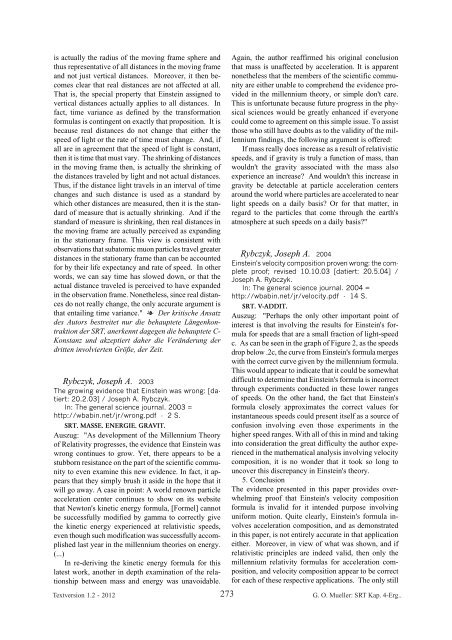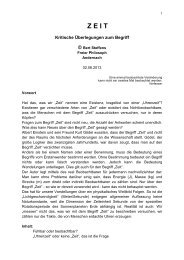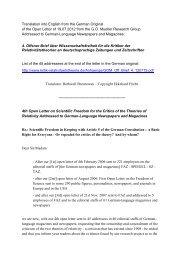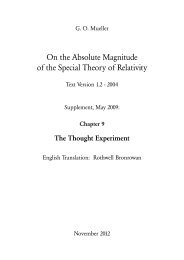2394 weitere kritische Veröffentlichungen - Kritische Stimmen zur ...
2394 weitere kritische Veröffentlichungen - Kritische Stimmen zur ...
2394 weitere kritische Veröffentlichungen - Kritische Stimmen zur ...
Sie wollen auch ein ePaper? Erhöhen Sie die Reichweite Ihrer Titel.
YUMPU macht aus Druck-PDFs automatisch weboptimierte ePaper, die Google liebt.
is actually the radius of the moving frame sphere and<br />
thus representative of all distances in the moving frame<br />
and not just vertical distances. Moreover, it then becomes<br />
clear that real distances are not affected at all.<br />
That is, the special property that Einstein assigned to<br />
vertical distances actually applies to all distances. In<br />
fact, time variance as defined by the transformation<br />
formulas is contingent on exactly that proposition. It is<br />
because real distances do not change that either the<br />
speed of light or the rate of time must change. And, if<br />
all are in agreement that the speed of light is constant,<br />
then it is time that must vary. The shrinking of distances<br />
in the moving frame then, is actually the shrinking of<br />
the distances traveled by light and not actual distances.<br />
Thus, if the distance light travels in an interval of time<br />
changes and such distance is used as a standard by<br />
which other distances are measured, then it is the standard<br />
of measure that is actually shrinking. And if the<br />
standard of measure is shrinking, then real distances in<br />
the moving frame are actually perceived as expanding<br />
in the stationary frame. This view is consistent with<br />
observations that subatomic muon particles travel greater<br />
distances in the stationary frame than can be accounted<br />
for by their life expectancy and rate of speed. In other<br />
words, we can say time has slowed down, or that the<br />
actual distance traveled is perceived to have expanded<br />
in the observation frame. Nonetheless, since real distances<br />
do not really change, the only accurate argument is<br />
that entailing time variance." � Der <strong>kritische</strong> Ansatz<br />
des Autors bestreitet nur die behauptete Längenkontraktion<br />
der SRT, anerkennt dagegen die behauptete C-<br />
Konstanz und akzeptiert daher die Veränderung der<br />
dritten involvierten Größe, der Zeit.<br />
Rybczyk, Joseph A. 2003<br />
The growing evidence that Einstein was wrong: [datiert:<br />
20.2.03] / Joseph A. Rybczyk.<br />
In: The general science journal. 2003 =<br />
http://wbabin.net/jr/wrong.pdf - 2 S.<br />
SRT. MASSE. ENERGIE. GRAVIT.<br />
Auszug: "As development of the Millennium Theory<br />
of Relativity progresses, the evidence that Einstein was<br />
wrong continues to grow. Yet, there appears to be a<br />
stubborn resistance on the part of the scientific community<br />
to even examine this new evidence. In fact, it appears<br />
that they simply brush it aside in the hope that it<br />
will go away. A case in point: A world renown particle<br />
acceleration center continues to show on its website<br />
that Newton's kinetic energy formula, [Formel] cannot<br />
be successfully modified by gamma to correctly give<br />
the kinetic energy experienced at relativistic speeds,<br />
even though such modification was successfully accomplished<br />
last year in the millennium theories on energy.<br />
(...)<br />
In re-deriving the kinetic energy formula for this<br />
latest work, another in depth examination of the relationship<br />
between mass and energy was unavoidable.<br />
Again, the author reaffirmed his original conclusion<br />
that mass is unaffected by acceleration. It is apparent<br />
nonetheless that the members of the scientific community<br />
are either unable to comprehend the evidence provided<br />
in the millennium theory, or simple don't care.<br />
This is unfortunate because future progress in the physical<br />
sciences would be greatly enhanced if everyone<br />
could come to agreement on this simple issue. To assist<br />
those who still have doubts as to the validity of the millennium<br />
findings, the following argument is offered:<br />
If mass really does increase as a result of relativistic<br />
speeds, and if gravity is truly a function of mass, than<br />
wouldn't the gravity associated with the mass also<br />
experience an increase? And wouldn't this increase in<br />
gravity be detectable at particle acceleration centers<br />
around the world where particles are accelerated to near<br />
light speeds on a daily basis? Or for that matter, in<br />
regard to the particles that come through the earth's<br />
atmosphere at such speeds on a daily basis?"<br />
Rybczyk, Joseph A. 2004<br />
Einstein's velocity composition proven wrong: the complete<br />
proof; revised 10.10.03 [datiert: 20.5.04] /<br />
Joseph A. Rybczyk.<br />
In: The general science journal. 2004 =<br />
http://wbabin.net/jr/velocity.pdf - 14 S.<br />
SRT. V-ADDIT.<br />
Auszug: "Perhaps the only other important point of<br />
interest is that involving the results for Einstein's formula<br />
for speeds that are a small fraction of light-speed<br />
c. As can be seen in the graph of Figure 2, as the speeds<br />
drop below .2c, the curve from Einstein's formula merges<br />
with the correct curve given by the millennium formula.<br />
This would appear to indicate that it could be somewhat<br />
difficult to determine that Einstein's formula is incorrect<br />
through experiments conducted in these lower ranges<br />
of speeds. On the other hand, the fact that Einstein's<br />
formula closely approximates the correct values for<br />
instantaneous speeds could present itself as a source of<br />
confusion involving even those experiments in the<br />
higher speed ranges. With all of this in mind and taking<br />
into consideration the great difficulty the author experienced<br />
in the mathematical analysis involving velocity<br />
composition, it is no wonder that it took so long to<br />
uncover this discrepancy in Einstein's theory.<br />
5. Conclusion<br />
The evidence presented in this paper provides overwhelming<br />
proof that Einstein's velocity composition<br />
formula is invalid for it intended purpose involving<br />
uniform motion. Quite clearly, Einstein's formula involves<br />
acceleration composition, and as demonstrated<br />
in this paper, is not entirely accurate in that application<br />
either. Moreover, in view of what was shown, and if<br />
relativistic principles are indeed valid, then only the<br />
millennium relativity formulas for acceleration composition,<br />
and velocity composition appear to be correct<br />
for each of these respective applications. The only still<br />
Textversion 1.2 - 2012 273<br />
G. O. Mueller: SRT Kap. 4-Erg..





